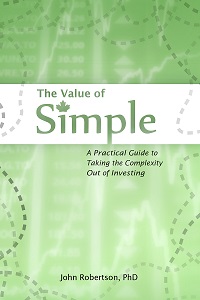On Robo-advisors
November 19th, 2015 by PotatoOne of my main focuses these days is helping people to get their money invested in a way that works for them for the long term. That’s why I started coaching people, and why I wrote The Value of Simple, to teach people how to do that on their own. Lots and lots of people have found it really useful and I’m very proud of that. Many can and should go the DIY route, but not everyone will want to or be well-suited to that method.
The robo-advisors sound like an excellent alternative, especially when combined with a fee-for-service planner for the complex bits that fall outside investing. I really like the idea of robo-advisors, but I had some reservations when they first came out. I’m glad to say that they are by and large knocking down my objections (in particular, moving from esoteric high-cost underlying funds to lower-cost broadly diversified portfolios, lower minimums, etc., though all-in pricing remains a challenge).
So far when someone has needed a hands-off DIY-ish solution like this, I’ve mostly been pointing them to Tangerine (covered in the book) in large part because Tangerine is a known quantity. A “known-known” if you would. I know first-hand that Tangerine is easy and smooth and painless, and what the tax statements will look like, that it minimizes analysis paralysis, and that all four asset classes are held in a single fund structure so rebalancing doesn’t lead to realized capital gains/losses in non-registered accounts1. Even just a few months ago, for people with smaller accounts Tangerine was really not any more expensive so it was an easy recommendation. As the robos have started using cheaper underlying funds and offering free passes to really small accounts, the cost difference has grown and the robos look more attractive. For people with larger accounts it was often a temporary recommendation, like “go with Tangerine for now and see what shakes out next year — you can switch then when there’s more clarity.” Note that I’m not trying to fear-monger with statements like that: I’m concerned with the customer experience rather than the safety of the money (which is held by reputable custodians covered by CIPF). Rest assured that even if the plethora of firms start to consolidate, or get swallowed by the big banks, or whatever, your investments there will be safe2.
There are still a few minor questions and quibbles3, but I’m the kind of person who will always have minor quibbles so at this point there’s no point in holding back from recommending them for investors who see value in their services. The main thing that’s missing is that first-hand experience, because no matter how easy they are to use it’s always handy to have a third-party walk-through to reassure people that it will all be ok, that the real-world situation lives up to the marketing4.
I wanted to make a grand guide to robo-advisors, kind of like a supplement to the book to compare them, including first-hand experience. I pitched it as a multi-part blog post guide as well as a flashy PDF summary. But I haven’t been able to secure the support to make that happen, and it’s too late in the year to include anything about tax reporting even if I was able to make that happen today. I still think a head-to-head mystery shop comparison would be really valuable, and I hope someone puts in the time and capital to do it (especially to do it in a way that includes challenging the services/concierges with dumb questions)… but it doesn’t look like I’m the right person to do it5.
Good behaviour is an essential part of long-term investing success, and is one area where I’m still not quite sure where the robo-advisors fall. On the one hand they largely use best practices to create broadly diversified portfolios and take away all the performance-chasing and what-not that individual investors and active managers are equally guilty of. Set it, forget it, automate it — they sound awesome. When markets roiled at the end of the summer they send out reassuring emails and had their staff standing by the phones. However, they also offer smartphone apps. At CPFC15, the CEO of one robo-advisor proudly proclaimed that a third of their clients check their smartphone app daily.
A third? Every day? I threw up in my mouth a bit.
That is just not a good thing for investor behaviour (but great for “engagement”). Even if there isn’t a big “panic sell” button in the app, frequently checking on a portfolio makes people feel the market ups and downs more vividly, which might lead them to do something drastic down the road (indeed, attempting to panic or alter my risk profile on the fly was something I wanted to check in the robo-advisor review/mystery shop to see how they handled the situation). Yes, Tangerine has an app, but it’s designed for your chequing account and it takes a few taps to get down to see your investments, and even there they only show you the balance in your investment account, with no flashy graphs of recent market drops or big red daily change numbers, and no individual segment reporting so you have to work a bit harder to activate your lizard brain.
But whatever, there’s nothing to do but see how things shake out, and with how fast things are moving those could be totally redesigned by next week.
So if you’re looking for a lower-cost way to get the investment implementation part of your finances handled — and don’t want to do a full DIY implementation — go ahead and check out the robo-advisors, and let me know how it goes. Remember that getting your savings invested is just part of the personal finance and planning challenge. A big, scary one to be sure, but just a part — your plan will be important for creating the context for those investments (like risk tolerance) and will be important for a bunch of other stuff unrelated to investing (like sleeping at night).
1 – and that they’re not playing silly buggers with esoteric asset classes and slicing-and-dicing, which I personally dislike but which I suppose I have to admit is not inherently evil.
2 – well, safe as can be expected: you may be inconvenienced, and still subject to the risks of the investments themselves — you’ll get your share of the ETF units back (or their market value at the time), but your principal is not guaranteed, just like investing anywhere else.
3 – like this post from WealthSimple. I’m not sure such expertise exists at all — and given that the fund in question under-performed a vanilla bond index when managed by the so-called professionals, I’m highly skeptical that if such expertise does exist that a small firm like WS will suddenly possess it in-house… and Eric Kirzner has been there since the beginning, which I should stop ranting about in the footnote. I will always find quibbles.
4 – to spot the unknown unknowns.
5 – in large part because I’m cheap and while the robo-advisors are relatively inexpensive, they’re still going to cost me a few hundred bucks more than DIY costs, on top of the PITA factor of actually doing it and then dealing with all these open accounts everywhere (which would all be non-registered accounts as my TFSA is full). And apparently I’m not persuasive enough to get them to sponsor an editorially independent comparison. [note to the footnote: I had not yet asked WealthSimple, in case they’re reading this and are all like “what, we never got such a request from Potato.” I figured the other rejections were enough to kill the idea.] {note to the note to the footnote: I had thought about trying to do a really small kickstarter, but as much as I think this sort of thing would be useful to the community, I don’t think anyone wants to fund it.}


 Questrade: use QPass 356624159378948
Questrade: use QPass 356624159378948 Passiv is a tool that can connect to your Questrade account and make it easier to track and rebalance your portfolio, including the ability to make one-click trades.
Passiv is a tool that can connect to your Questrade account and make it easier to track and rebalance your portfolio, including the ability to make one-click trades.